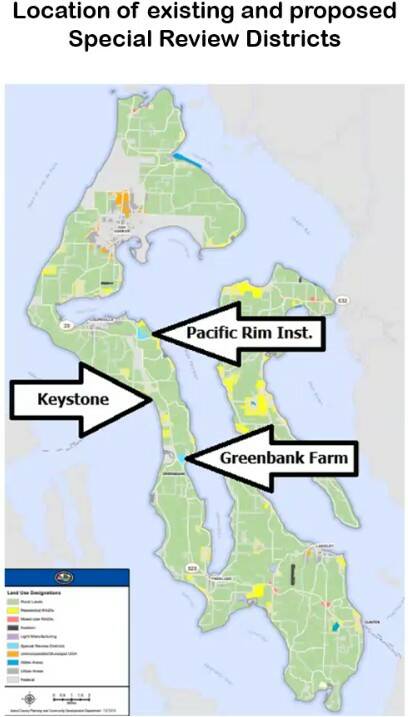Whidbey Island has a new special review district.
Unanimously approved by Island County commissioners last week, the Keystone Farm and Forest Preserve owned by the Whidbey Camano Land Trust became the island’s third special review district, joining Greenbank Farm and the Pacific Rim Institute.
Special review districts are created to enhance, conserve or highlight areas of historical, archaeological or environmental significance. The districts must consist of an area of at least 150 acres and can be owned or managed by a nonprofit organization, in the case of the Whidbey Camano Land Trust.
John Lanier, a long range planner for the county, told the commissioners that the Keystone Preserve will protect 216 acres of land and 3,500 feet of shoreline and provide a location for land trust offices on site. Lanier explained that the land trust has restored 1,000 feet of a stream to its original channel, avoiding bluff erosion, and removed 300 feet of creosoted bulkhead and a 3,000-square-foot residence on the shoreline.
A map of the preserve’s layout shows a natural area, a farmland area and the main complex for the conservation center. The natural area will allow for trails and hiking uses, while the farm area will be a showcase for sustainable agriculture practices, with some possible improvements such as a greenhouse or processing buildings. The conservation center will house land trust offices and other possible future improvements like a commercial kitchen, farm stand, a stewardship building with a workshop and, with proper permitting, potential workforce housing.
“This is a big moment for Island County, something for the future of the community,” Lanier said.
Commissioner Melanie Bacon asked about the benefit to taxpayers in making this particular property a special review district. Lanier responded that the community will benefit from public use of this land. The action will preserve the property and keep it from being sold to developers, creating zoning that doesn’t really allow for subdivision and single family housing.
“So there’s no provisions in there for just adding housing, except for the possibility of some workforce housing in the conservation center area there, which wouldn’t take away from the preserve,” Lanier said.
In addition, there is the opportunity for tribal engagement, allowing for hunting, fishing and gathering on important sacred and cultural sites. Lanier said the land trust is consulting with the tribes to explore how they want to access the preserve.
There are also partnerships with other entities and organizations, including the Organic Farm School, school districts, the Whidbey Island Conservation District, the Whidbey Audubon Society and Sound Water Stewards.
Bacon asked why Keystone Preserve needs to be a special review district, compared to the land trust’s other properties throughout the county. Lanier responded that their plan is to showcase a number of ecological restorative processes for the public to come in and see.
“It’s kind of the kismet, or the synergy, of having everything there,” he said. “They have the office there. They have examples of lands that they have restored there. They have lands that they work on regenerative farming there, so that it’s kind of all on one side.”
Commissioner Jill Johnson said she thought it was a matter of a zoning permitting process question, not the value of purchasing the land and what actions could happen on it. Lanier said they were working on the process, and outside of it, the only things the land trust would have to obtain additional permitting for would be special events or housing.
In the end, the commissioners adopted the ordinance establishing the special review district in a 3-0 decision.
Jennifer Hajny, the Whidbey Camano Land Trust’s community engagement director, said the new designation will help ensure that the land trust can deliver the best possible services to the community when the preserve opens to the public next year.



